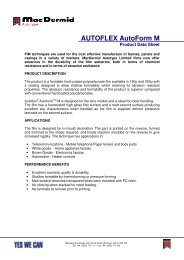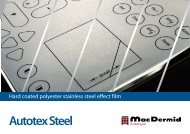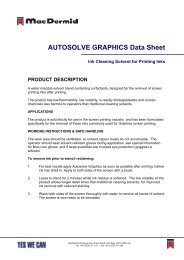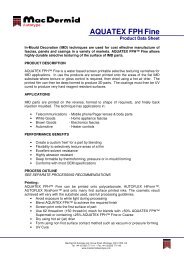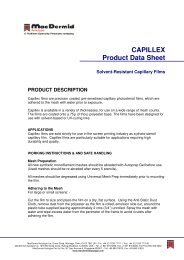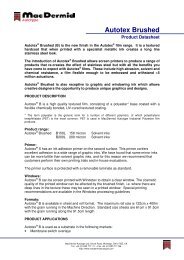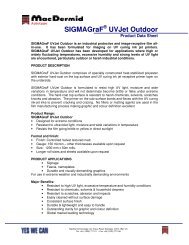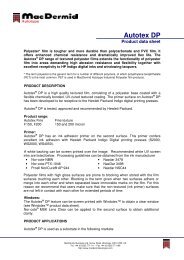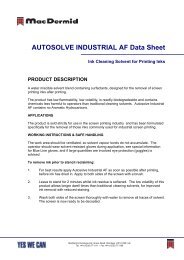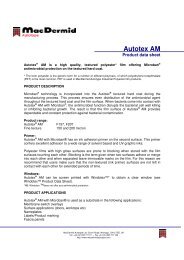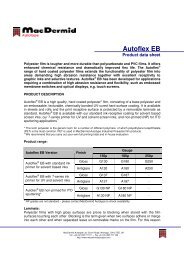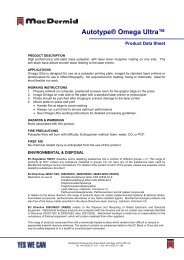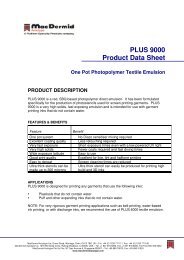Screen E-Book (.PDF) - MacDermid Autotype
Screen E-Book (.PDF) - MacDermid Autotype
Screen E-Book (.PDF) - MacDermid Autotype
- No tags were found...
You also want an ePaper? Increase the reach of your titles
YUMPU automatically turns print PDFs into web optimized ePapers that Google loves.
Moiré characteristicsThere are three things that characteriseany moiré: its frequency, angle, and amplitude(or intensity). A lot of the confusionabout moiré comes from not understandingthe relative importance of thesecharacteristics. There is a fourth componentwhich is often forgotten, and that isthe human eye. It is the human eye thatdictates the relative importance of thethree moiré characteristics.1 - FrequencyWe are all used to specifying frequenciesin screen printing. When we talk aboutan 80 lpi (32tpc) halftone we are describingits frequency. Sometimes when wetalk about moirés we say that they repeatevery 0.5” (1.3cm). This half inch is the periodand is the inverse of the frequency. Sothe frequency of a 0.5” moiré is 1/0.5=2 lpi(1/1.3=0.8 lpc)This talk about frequencies is very important.It’s very easy to do theoretical calculationsand prove that you have a moiré witha frequency of, say, 40 lpi (16tpc). You thenhave to ask whether this frequency wouldshow up in the print. In one way, the answermust always be ‘yes’ it will show up.Try hard and you will be able to find it. Butas printers we are only interested in onequestion: will the customer see it? In principle,the customer might try hard to findit. But let’s assume that the customer hassome intelligence. The customer wantsthe print to look good for its purpose. Soexamining a large poster with a high-poweredmicroscope is not relevant. On theother hand, viewing a printed DVD fromtoo far way is also not relevant.It turns out that there is a useful rule ofthumb – the MRN Rule of 4. Divide the frequencyof your print by the frequency ofyour moiré. This is your Moiré Ratio Number(MRN). In this case, Big is Bad. A highMRN means a high visibility moiré. If theMRN is less than 4 then you’re probably OK.So for your 80 lpi (32tpc) print, a moiré ofmore than 20 lpi (8tpc) will not be a problem.I recently had a startling reminder ofthe validity of this rule. I was shown sometruly ugly prints with a really vicious moiré.I was amazed that any customer had paidfor these prints. But they were prints witha very low lpi (32 lpi, 12tpc), designed forviewing from a reasonable distance. Sureenough, when you put them at their viewingdistance, not only did the moiré disappear,but the prints looked stunninglygood. Whoever had designed them had agreat artistic sense, and the faith to ignorethe strong moiré visible at close distances.The particular moiré had a frequency of8.4 lpi (3.3tpc) so its MRN was 32/8.4=3.8,just below the Rule of 4 limit, and great forthe viewing distance of a 32 lpi image. An8.4 lpi moiré on an 80 lpi print (MRN=9.5)would be a catastrophe!Why does the rule apply? Surely a moiréis a moiré? But remember the fourth factor– the human eye. It only has so muchresolution and below that resolution it105



